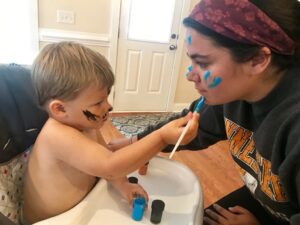Child Directed Interaction Therapy
What is it?
CDIT is an evidence-based treatment for young children (2-7 years old) with behavioral difficulties. CDIT is conducted through “coaching” sessions between a parent and the child in a playroom. The therapist is in an observation room watching the parent and child interacteractions through a one-way mirror.
We will provide a walkie-talkie with a small earpiece to receive coaching by a therapist trained in CDIT. The child will have no awareness of the earpiece. The therapist trained in CDIT will teach the parent to incorporate PRIDE during play.
What does PRIDE stand for?
P– Praise your child. We want to praise the child for specific reasons. “Good job” does not inform your child on what they did. However, “Good job putting that block on gently” does!
R- Reflect appropriate talk. Imitate and add on to what your child is saying during play. “That is big” “WHOA, that is so big!”. This shows them you are listening to them and increases the chance of positive communication between you and your child.
l- Imitate appropriate play. Let the child take the lead. If they are making a doll jump, grab another doll and have it jump. This helps your child learn how to play with others and increases the chance of your child imitating what you will do.
D- Describe appropriate behavior. Again, we let your child take the lead, and instead of asking questions, we describe what they are doing. “You have a red block… oh you put it on the bus!”. These provide verbal models for speech, shows your child you are engaged, teaches concepts, and holds your child’s attention.
E- Enthusiasm. Using enthusiasm during play shows your child you are interested in them, models appropriate positive emotions, and strengthens a positive relationship. “WOW, that is SO cool!”
As a parent, is there anything I should avoid during play?
- Asking questions. “Is that a cow?” Your child may not know the answer to your question and shut down. Questions pause the conversation at hand and decrease expressive language skills. Instead of asking questionstry labeling/describing behavior, “You have a cow!” “Cow” “Yes! A cow”.
- Giving directions. We want your child to take the lead and directions prohibit this to happen. “Give me the dragon.” “Put the girl on the chair”. Chances are your child will not follow your direction, possibly stop the task at hand, and start a new activity on their own. We know it is hard, but let the child lead and incorporate those PRIDE skills during play!
Throughout this structured program, Child Directed Interaction Therapy (CDIT), parents work collaboratively to refine specific skills to establish a nurturing and secure relationship with their child. Combining CDIT, occupational and speech-language therapy, will help your child to successfully develop through the different social-emotional stages. It will also improve the warmth in your relationship while focusing on activities of daily life and improving your child’s communication skills. Therapists will use the following behavioral techniques:
- Reflections: Imitating your child’s verbalizations and adding on to it. This will help increase your child’s expressive language skills by increasing his/her sentence length and expand his/her verbal output during conversations with others.
- Behavioral Descriptions:Describing/talking about what your child is doing instead of questioning increases his/her language and confidence.
- Imitation: You can imitate movements AND verbalizations. For example, if your child begins to clap, you can join in on clapping! Pragmatics (social skills) can be targeted through imitation as that lets your child know you are engaged and interested with the task at hand.
- Labeled Praises:“I like the way you cleaned up”. Labeled praises help with language and motor planning skills. With a labeled praise, a child learns what they did, where they did it, who was involved, etc. in a loving environment, all thanks to YOU!
Another benefit to the combination of CDIT and OT is the therapists focus on increasing sustained attention and ability to follow directions. CDIT allows the therapist to guide the parent into their child’s world, and ultimately create a bond that expands your child’s world to more than just their preferred tasks.
* Miss Sadie was part of a research study conducted by Dr. John Paul Abner through Milligan College Occupational Therapy School. The study was conducted in Fall 2019, with approval from the PCIT board, to assess Occupational Therapy and Speech and Language Pathologists ability to complete and implement training for the first phase of PCIT. They were then asked to complete CDIT for 8 weeks with 4 or more families. Dr. Abner and his research team presented positive outcomes to the trainees.*

